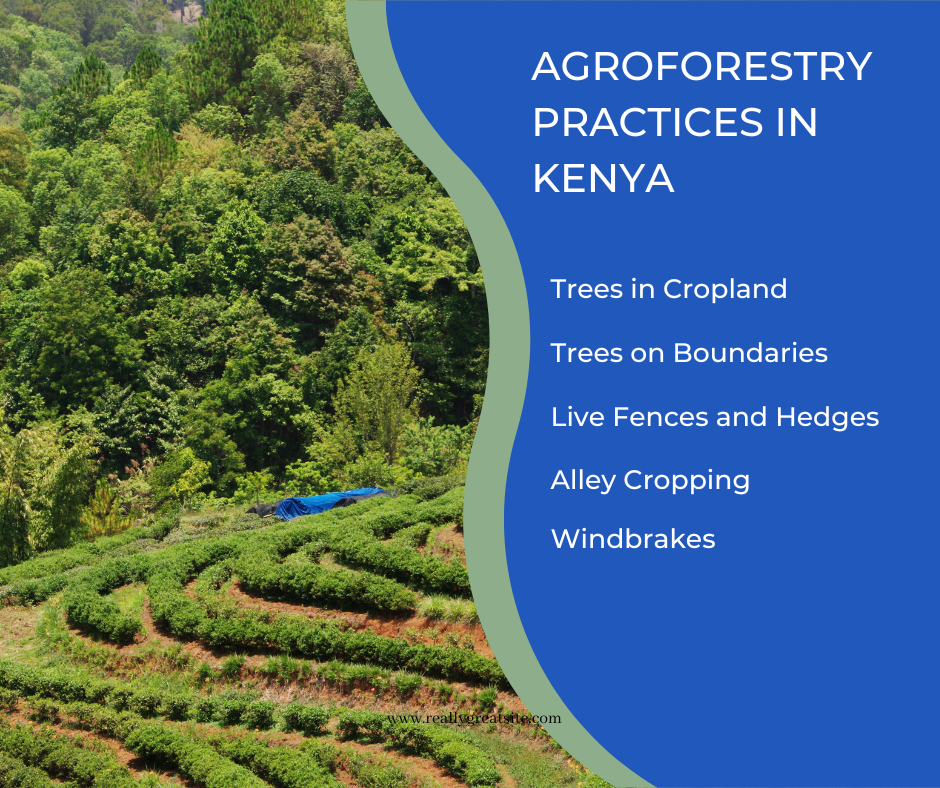Contact: +91 99725 24322 |
Menu
Menu
Quick summary: Discover how agroforestry practices are transforming Kenya's agricultural landscape, bolstering food security and sustainability while empowering smallholder farmers. Explore the innovative techniques and collaborative efforts driving positive change in this vital sector.

Agroforestry in Kenya represents more than just a farming technique; it embodies a harmonious relationship between nature and agriculture, offering a path towards environmental stewardship and community prosperity. Agroforestry is the integration of trees and shrubs into agricultural systems, resulting in a more sustainable and diverse landscape.
Kenya aims to abate up to 4.1 MtCO2e by 2030 through implementing agroforestry over 281,000 hectares between 2015 and 2030.
Agroforestry is important in Kenya because it improves food security, conserves soil and water resources, mitigates the effects of climate change, and provides farmers with extra revenue streams.
Kenya’s economy is significantly influenced by its agriculture sector, which encompasses crops, livestock, fisheries, agroforestry, and related services. Despite progress in other economic domains, agriculture remains the primary contributor to Kenya’s Gross Domestic Product (GDP), directly accounting for approximately 33%, with an additional 27% indirectly through connections to agro-based industries and the service sector. Moreover, this sector is a vital source of employment, engaging over 40% of the total population and nearly 70% of the rural populace. The agriculture sector is mainly dominated by small-holder farmers with most production being carried out on farms averaging 0.2–3 hectares.
Dominated mainly by smallholders and reliant on rain-fed farming, the sector is highly vulnerable to climate fluctuations and extreme weather events. The agricultural transformation envisioned for Kenya prioritizes the development of a dynamic, modern, and commercially driven agricultural sector that can support the country’s economic, social, and ecological objectives while ensuring food and nutrition security.
Agroforestry is critical for Kenya’s sustainable agriculture because it improves soil fertility, increases crop yields, and strengthens resilience to climate change. Farmers can diversify their income streams by incorporating trees into their agricultural methods, such as selling lumber, fruits, and other tree products. Agroforestry also supports biodiversity and ecosystem services, which help farming communities maintain long-term environmental sustainability and economic stability. Kenyan farmers are implementing novel agroforestry practices to meet rising challenges and optimize agricultural productivity while conserving natural resources.
Kenya’s agricultural sector heavily relies on natural resources, but faces significant challenges from land degradation, particularly impacting smallholder farmers. Soil fertility is low in high precipitation areas, compounded by acidity and inadequate erosion control. Climate change further exacerbates these issues, jeopardizing farmers’ ability to cope, especially during underperforming value chains. Agroforestry emerges as a solution, enhancing farmers’ adaptive capacity through diversified enterprises and safeguarding ecosystem services critical for sustained productivity and climate resilience.
Traditional agroforestry systems have long been used by Kenyan communities to manage land resources responsibly and boost agricultural productivity. These systems often integrate trees, crops, and livestock in a way that resembles natural ecosystems. Traditional agroforestry practices in Kenya include planting trees alongside food crops like maize and beans, as well as incorporating livestock grazing spaces into wooded landscapes. These systems offer numerous advantages, including higher soil fertility, improved water retention, increased biodiversity, and additional revenue streams from the sale of timber, fruits, and fodder.

Modern agroforestry practices in Kenya are progressively embracing scientific research and development to improve productivity and sustainability. These strategies frequently include the use of improved tree species, precision farming procedures, and the incorporation of agroforestry into other modern agricultural technologies such as irrigation and soil conservation. Furthermore, current agroforestry programmes in Kenya frequently target specific issues such as climate change adaptation, soil degradation, and food security. Research and development programmes work with farmers to implement novel agroforestry techniques that are customised to local conditions, combining indigenous knowledge with modern ways to increase agricultural resilience and livelihoods.
The deployment of agroforestry systems in Kenya has resulted in higher crop yields and more diverse income streams for rural farmers. By incorporating trees into their agricultural operations, farmers can improve soil fertility, reduce erosion, and boost water retention, resulting in improved yields of staple crops like maize, beans, and vegetables. Furthermore, cultivating trees for lumber, fruits, and other items provides farmers with various revenue streams, reducing their reliance on a single crop and increasing their overall economic resilience.
Rural communities in Kenya have improved their livelihoods by adopting agroforestry practices. By diversifying their agricultural activities and adding trees into their farming systems, communities have been able to boost overall production and profitability. Agroforestry also provides environmental benefits such as carbon sequestration biodiversity conservation, and improved ecosystem services, all of which help rural communities thrive. Farmers that participate in agroforestry research and development programmes also receive access to valuable knowledge, resources, and support networks, which improves their ability to manage their land sustainably and enhance their livelihoods.
Kenya’s government-led programmes aim to promote agroforestry as a sustainable land management method. The Kenya Agroforestry Strategy, produced by the government, specifies important objectives and tactics for incorporating trees into agricultural systems. This includes giving technical help, training, and financial incentives to farmers that implement agroforestry systems. Government agencies seek to set rules and regulations that promote agroforestry, as well as collaborate with research institutions to develop innovative techniques and technologies.
Non-governmental organisations (NGOs) and community projects play critical roles in promoting agroforestry in Kenya. Through programmes such as the Vi Agroforestry programme, NGOs engage directly with farmers to give training, resources, and assistance for adopting agroforestry practices on their property. These organisations frequently work with local communities to create awareness about the benefits of agroforestry and promote information sharing among farmers.
To address these issues, measures such as providing farmers with training and extension services, advocating for policy reforms that encourage agroforestry, and building nurseries to produce low-cost tree seedlings might be implemented. Strengthening collaboration across academic institutions, government agencies, and non-governmental organisations can also help with knowledge exchange and resource mobilisation. Furthermore, encouraging community participation and incorporating agroforestry into larger sustainable development programmes can help establish a favourable environment for adoption.
Technology solutions like the Digital MRV (Measurement, Reporting, and Verification) platform from TraceX play a crucial role in agroforestry projects by providing accurate data collection and monitoring capabilities.
1. Data Collection: The digital MRV platform enables systematic data collection on various aspects of agroforestry projects, including tree planting, growth rates, biodiversity, and carbon sequestration. This comprehensive data collection ensures that project managers have access to reliable information for decision-making and reporting purposes.
2. Monitoring and Reporting: By continuously monitoring key parameters such as tree growth, soil health, and ecosystem services, the digital MRV platform allows for real-time insights into the progress and effectiveness of agroforestry initiatives. This enables project managers to identify any issues or challenges early on and take corrective actions as needed. Additionally, the platform facilitates accurate reporting on project outcomes, ensuring transparency and accountability to stakeholders.
3. Verification of Impact: One of the critical aspects of agroforestry projects is verifying their impact, particularly in terms of carbon sequestration and biodiversity conservation. The digital MRV platform facilitates the verification process by providing robust data analytics and visualization tools. This allows project managers to quantify the environmental benefits of their initiatives accurately and demonstrate compliance with sustainability standards and certification requirements.
Kenya has tremendous potential for expanding agroforestry methods due to its diversified agro-climatic conditions, which support a wide range of tree species and agricultural crops. The country’s Agroforestry Strategy seeks to encourage the use of sustainable agroforestry systems by incorporating trees into agricultural landscapes. Kenyan farmers are being equipped with information and resources to implement innovative agroforestry tactics thanks to research and development programmes done by organisations such as CIFOR and VI Agroforestry. Kenya can strengthen its agroforestry sector by using these partners’ expertise and building on existing programmes to improve food security, raise resistance to climate change, and promote sustainable land management practices.
In the arid landscapes of eastern Kenya, smallholder farmers are reaping the rewards of innovative farming methods pioneered through collaboration with scientists from the World Agroforestry (ICRAF), alongside development and government stakeholders. These techniques have proven to be instrumental in bolstering food security, a trend that local farmers are eagerly embracing.
Finally, Kenya has enormous potential for scaling up agroforestry methods, aided by its diversified agro-climatic conditions and the collaborative efforts of numerous stakeholders. Farmers are being equipped with the information and tools they need to implement sustainable agroforestry systems thanks to joint initiatives conducted by government agencies, academic institutions, NGOs, and international organisations. Stakeholders are accelerating the implementation of agroforestry in Kenya by leveraging technical skills, providing training programmes, and campaigning for favourable policy. This holistic strategy not only improves food security, climate resilience, and sustainable land management, but it also helps to conserve biodiversity and improve rural livelihoods. Moving forward, more collaboration and investment in agroforestry programmes will be required to fully realise the promise of this approach in Kenya and elsewhere.
